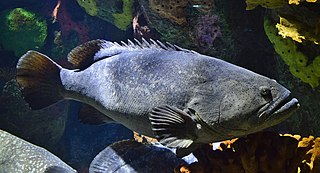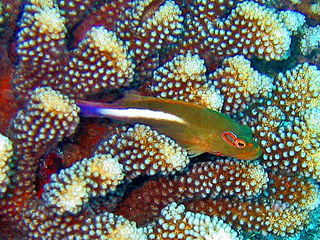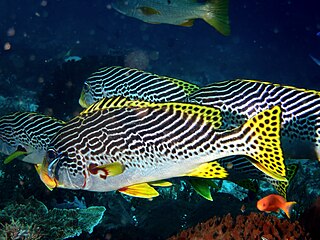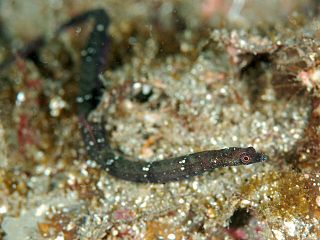
The zebra shark is a species of carpet shark and the sole member of the family Stegostomatidae. It is found throughout the tropical Indo-Pacific, frequenting coral reefs and sandy flats to a depth of 62 m (203 ft). Adult zebra sharks are distinctive in appearance, with five longitudinal ridges on a cylindrical body, a low caudal fin comprising nearly half the total length, and usually a pattern of dark spots on a pale background. Young zebra sharks under 50–90 cm (20–35 in) long have a completely different pattern, consisting of light vertical stripes on a brown background, and lack the ridges. This species attains a length of 2.5 m (8.2 ft).

The giant grouper, also known as the Queensland grouper, brindle grouper or mottled-brown sea bass, is a species of marine ray-finned fish, a grouper from the subfamily Epinephelinae which is part of the family Serranidae, which also includes the anthias and sea basses. It has a wide Indo-Pacific distribution and is one of the largest extant species of bony fish.

The girdled wrasse, Notolabrus cinctus, is a species of wrasse native to the waters around the South Island and southeastern North Island of New Zealand, including the Chatham Islands and Snares Islands, where it can be found at depths from 15 to 91 m. The males of this species can reach 29.9 cm (11.8 in) in standard length, while the females only reach 29.1 cm (11.5 in). There are two colour phases with older fish developing a large, dusky belt around the body. This is not associated with changing sex which happens about three years after the development of the belt. They feed on molluscs and small crustacea. They occur on rocky reefs, where they are common.

Plectorhinchus is a genus of marine ray-finned fish, sweetlips belonging to the subfamily Plectorhinchinae which is one of two subfamilies in the family Haemulidae which also includes the grunts. The species in this genus are found in fresh, brackish, and salt waters.

The hawksbill sea turtle is a critically endangered sea turtle belonging to the family Cheloniidae. It is the only extant species in the genus Eretmochelys. The species has a global distribution, that is largely limited to tropical and subtropical marine and estuary ecosystems.

Plectropomus laevis, known commonly as the black-saddled coral grouper, cluespotted coral trout, blacksaddled coral trout, blue-spot trout, Chinese footballer, footballer cod, footballer coral trout, oceanic coral trout or tiger trout, is a species of marine ray-finned fish, a grouper from the subfamily Epinephelinae which is part of the family Serranidae, which also includes the anthias and sea basses. It is found in the Indo-Pacific region.

The yellow prawn-goby is a species of goby native to the Western Pacific, where it can be found at depths of from 1 to 25 metres in coastal bays and lagoons. This species is symbiotic with alpheid shrimps. The species can reach a length of 10 centimetres (3.9 in) SL. These fish vary greatly in appearance, ranging from brilliant yellow to gray and even brown forms or combinations of each coloring. This species is often kept in salt water aquariums. The yellow prawn-goby can be kept in aquariums as small as 20 gallons. In the marine hobby they are often partnered with tiger pistol shrimp.

The arc-eye hawkfish, the ringeye hawkfish, horseshoe hawkfish or whiteline hawkfish, is a species of marine ray-finned fish, a hawkfish belonging to the family Cirrhitidae. It is found in shallow waters in the tropical Indo-Pacific on reefs, resting on coral heads much of the time.

Plectorhinchus lineatus also known as the yellowbanded sweetlips, oblique-banded sweetlips, diagonal-banded sweetlips, Goldman's sweetlips, lined blubber-lips, lined sweetlips, many-lined sweetlips, striped sweetlips and yellowband sweetlips, is a species of marine ray-finned fish, a sweetlips belonging to the subfamily Plectorhinchinae, one of two subfamilies in the family Haemulidae, the grunts. It inhabits coral reefs of the western Pacific Ocean, where it occurs at depths from 1 to 35 m.
Choeroichthys cinctus is a species of marine fish of the family Syngnathidae. It is found in the Western Pacific Ocean, from Indonesia and the Philippines to Samoa, where it usually inhabits sheltered reef habitats at depths over 10 metres (33 ft). It can grow to lengths of 10 centimetres (3.9 in). This species is ovoviviparous, with males carrying eggs in a brood pouch until giving birth to live young. Males may brood at 3 centimetres (1.2 in).
Choeroichthys suillus is a species of marine fish of the family Syngnathidae. It is endemic to Australia, occurring from Perth, along northern Australia, to southern Queensland. It lives in coral reefs to a depth of 14 metres (46 ft), where it can grow to lengths of 6 centimetres (2.4 in). This species is ovoviviparous, with males carrying eggs and giving birth to live young. Within the reef it is found among coral rubble.
Cosmocampus darrosanus is a species of marine fish of the family Syngnathidae. It is found in the Western Indian Ocean, Sri Lanka, Indonesia, Guam, and the Great Barrier Reef (Australia). It lives in tidepools and coral reefs to depths of 3 metres (9.8 ft), where it can grow to lengths of 7.4 centimetres (2.9 in). This species is ovoviviparous, with males carrying eggs before giving birth to live young.

Doryrhamphus negrosensis, commonly known as Negros pipefish, flagtail pipefish, Masthead Island pipefish or Queensland flagtail pipefish, is a species of marine fish of the family Syngnathidae. It is found in the Western Pacific Ocean, from Borneo to Vanuatu and the Yaeyama Islands to the Rowley Shoals and the Great Barrier Reef. It lives in mud flats and reefs, both coral and rocky, where it is often associated with sea urchins. It is a rather solitary species which may be found in pairs or small groups. It inhabits depths to 9 metres (30 ft), and can grow to lengths of 6.2 centimetres (2.4 in). Although little is known of its feeding habits, it is expected to feed on harpacticoid copepods, gammarid shrimps, and mysids, similar to other pipefish, it may also act as a cleaner fish like other species in the genus Doryrhamphus. This species is ovoviviparous, with males carrying eggs before giving birth to live young. Males may brood at 4.3 cm. It is a small bluish to bluish-grey pipefish which has a pale stripe along the dorsal side of the head and snout, and a dark fan-like caudal fin which has white margins and an orange base.

Dunckerocampus pessuliferus, occasionally Doryrhamphus pessuliferus, is a species of marine fish of the family Syngnathidae. It is a coastal species, inhabiting waters around the Coral Triangle, including the Philippines, Indonesia, and northwestern Australia. It lives in coral patches on sandy and muddy slopes at depths of 15–44 metres (49–144 ft), where it can grow to lengths of 16 centimetres (6.3 in). It is an active cleaner, feeding off of parasitic crustaceans growing on other fishes. The adult fish form pairs and are normally observed swimming along the bottom around large remote coral heads on muddy slopes. This species is ovoviviparous, with males carrying eggs and giving birth to live young.
Festucalex cinctus is a species of marine fish of the pipefish family Syngnathidae which is endemic to the waters off eastern Australia.

Booth's pipefish is a species of marine fish of the family Syngnathidae. It is found in the Western Indian Ocean, in South Africa and the Comoro Islands, and in the Western Pacific, from South Korea and Japan to the Great Barrier Reef and Tonga. It lives in rocks and coral reefs to depths of 30 metres (98 ft), where it can grow to lengths of 17.5 centimetres (6.9 in). This species is ovoviviparous, with males carrying eggs and giving birth to live young.

The Samoan pipefish, or brown pipefish, is a species of marine fish of the family Syngnathidae. It is found in the Indo-Pacific, from the Red Sea, to Sodwana Bay, to Taiwan, the Marshall Islands, and Samoa, where it inhabits tidepools and coral and rocky reefs to depths of 15 metres (49 ft). It is a solitary species with cryptic habits and is rarely observed. It is likely to feed on small crustaceans, and can grow to lengths of 14 centimetres (5.5 in). This species is ovoviviparous, with males carrying the fertilised eggs in a brood pouch, the folds of which fall well short of the centre of the egg-filled pouch, eventually giving birth to live young.

Vanacampus vercoi, also known as Verco's pipefish is a species of marine fish belonging to the family Syngnathidae. They can be found inhabiting seaweed and seagrass beds in addition to tidepools at depths between 2–4 meters from Spencer's Gulf to Encounter Bay, South Australia. Their diet likely consists of small crustaceans such as amphipods and copepods. Reproduction occurs through ovoviviparity in which the males brood eggs before giving live birth.

The halfbanded angelfish is a species of marine ray-finned fish, a marine angelfish belonging to the family Pomacanthidae. It is found in the southwestern Pacific Ocean.

The Argentine seabass is a species of seabass in the family Serranidae. It occurs on the South American continental shelf of the western Atlantic Ocean, where it used to be caught commercially for human consumption.

















